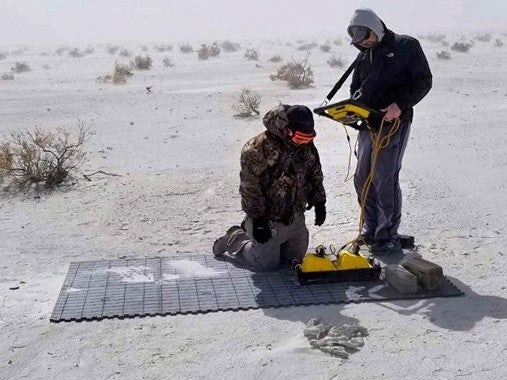The Independent's journalism is supported by our readers. When you purchase through links on our site, we may earn commission.
‘Ghost’ footprints hiding since end of last ice age revealed by new radar technique
Technique could be used to investigate movements of ancient humans, animals and even dinosaurs

Your support helps us to tell the story
From reproductive rights to climate change to Big Tech, The Independent is on the ground when the story is developing. Whether it's investigating the financials of Elon Musk's pro-Trump PAC or producing our latest documentary, 'The A Word', which shines a light on the American women fighting for reproductive rights, we know how important it is to parse out the facts from the messaging.
At such a critical moment in US history, we need reporters on the ground. Your donation allows us to keep sending journalists to speak to both sides of the story.
The Independent is trusted by Americans across the entire political spectrum. And unlike many other quality news outlets, we choose not to lock Americans out of our reporting and analysis with paywalls. We believe quality journalism should be available to everyone, paid for by those who can afford it.
Your support makes all the difference.“Ghost” footprints hidden since the end of the last ice age have been revealed by scientists using a new radar method which they hope could be used to investigate the movements of humans, animals and even dinosaurs.
Researchers at America’s prestigious Cornell University hope it could be used to discover the fossilised footprints of humans, mammoths and giant slots at the White Sands National Monument in New Mexico.
They said the recently discovered ancient impressions revealed a wealth of information about humans and animals moved around and interacted with each other 12,000 years ago.
The method could be used to learn about what early humans did when they were not at a campsite or a hunt kill site – the two types of archaeological areas best known for the time period.
“We never thought to look under footprints,” said Thomas Urban, a research scientist at Cornell and lead author on the study. “But it turns out that the sediment itself has a memory that records the effects of the animal’s weight and momentum in a beautiful way. It gives us a way to understand the biomechanics of extinct fauna that we never had before.”
By using ground-penetrating radar (GPR), the researchers were able to resolve 96 per cent of the human tracks in the area under investigation.
“But there are bigger implications than just this case study,” Mr Urban said. “The technique could possibly be applied to many other fossilised footprint sites around the world, potentially including those of dinosaurs. We have already successfully tested the method more broadly at multiple locations within White Sands.”
GPR allows researchers to access hidden information without the need for excavation, the researchers said in the journal Scientific Reports.
The sensor is dragged over the surface, sending radio waves into the ground, which then bounce back and give a picture of what sits below the surface.
While the hidden footprints can become visible for a brief amount of time after rain or when conditions are just right, they can now “be recorded, traced and investigated in 3D to reveal Pleistocene animal and human interactions, history and mechanics in genuinely exciting new ways,” said Sturt Manning, a co-author and archaeology professor.
Mr Urban added: “The GPR technique gets us to the space in between [sites] and lets us see how people are tracking animals or moving around for other tasks of daily life. There are very few footprint records of human-megafauna interactions. It’s really rare to have access to this kind of data from 12,000 or more years ago.”
Join our commenting forum
Join thought-provoking conversations, follow other Independent readers and see their replies
Comments